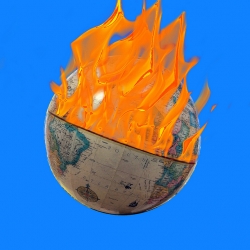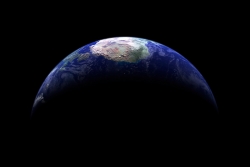It's time to do a doctor's checkup on the earth. I mean, it is
four billion years old. We should probably do one of these checkups at least every thousand years or so. How can we tell if the earth is healthy? First, we will take a look at its color. Blue and green . . . seems pretty good. Next, we will see if it's a little gassy
. Whew! It is, but that isn't always a bad thing. Last, we will use the best way to tell if something is healthy or not. We will take Earth's temperature. Let's hope it isn't too high. If the earth is sick, the living things who live on it may get sick too.
If a person is gassy, you might think they ate something bad and tell them to stay away from you. If the earth is gassy, it means it's healthy and you have plenty of air to breathe! The
atmosphere is all the gases that wrap around Earth like a blanket. These gases begin at the dirt we walk on and stretch three hundred miles up into the sky! Yes, the earth is really gassy . . . and that's a good thing. These gases not only let us breathe, they also keep us warm. Not in a gross way.

It's warm enough on Earth for plants and animals to live. You can thank our atmosphere for that!
Juliana Phang/Flickr.com
Now it's time to take Earth's temperature. It needs to be not too cold, not too hot, but just right. Hmm. It feels a little cold right now. We will have to do something about that. One big reason there is life on Earth is because the Sun sends a lot of light and heat our way. If we did not have this heat, the earth would be covered in ice. It would have a serious cold.
Radiation is heat that moves through space and matter as waves to reach us here on Earth. These waves are like medicine that keeps all life going. Just because a doctor gives you lots of medicine, doesn't mean you're not going to spit it out though. The earth needs a way to hold on to this medicine in.
Heat hits Earth's ground and water, warming up the air. Some of the heat bounces right back into space. Almost like the earth is spitting some of its medicine out. It does not spit all of it out though. Some of it stays trapped
. Greenhouse gases are certain gases around the earth that trap heat and keep us warm. Carbon dioxide and ozone are just two of them. If we did not have these, too much heat would bounce back into space, and Earth would catch that bad cold. These are gases no one should be embarrassed about.
Put your hand on Earth's forehead. Feels a little warm now, right? That's a good thing! The
greenhouse effect is when the gases around Earth absorb heat that was trying to escape, and this helps to keep Earth warm. Does Earth's forehead feel a little cooler now? That's okay too. Unlike a person, the earth's temperature can move up and down quite a bit and still be healthy. Earth can, of course, get too hot or too cold. Lately, the earth has been a little on the warm side. People release a lot of extra gases by using cars and factories. These gases might be trapping too much heat, leading Earth to a bad fever.

The planet has been feverish lately.
Bill Smith from Virginia Beach, CC BY 2.0 , via Wikimedia Commons
Checkup finished! Earth has a pretty good color. Blue and green with clear skies. It's a little gassy, but that makes an atmosphere, which helps us breathe. The greenhouse gases in the high part of the sky also trap the sun's radiation making sure it's warm enough for us to live. This is called the greenhouse effect, and it can make Earth's temperatures go up and down a lot. It's good to keep an eye on these things and how the things we do on Earth change its health. We would not want to live on an earth that had a bad cold or a bad fever.

We need to take care of our planet that takes care of us.
Kevin Gill/Flickr.com
References:
Climate Kids. "What Is the Greenhouse Effect?" NASA, 2011. <
http://climatekids.nasa.gov/greenhouse-effect/>
Clean Air Kids. "Greenhouse Effect and Global Warming" Clean Air Kids, 2008. <
http://www.clean-air-kids.org.uk/globalwarming.html>